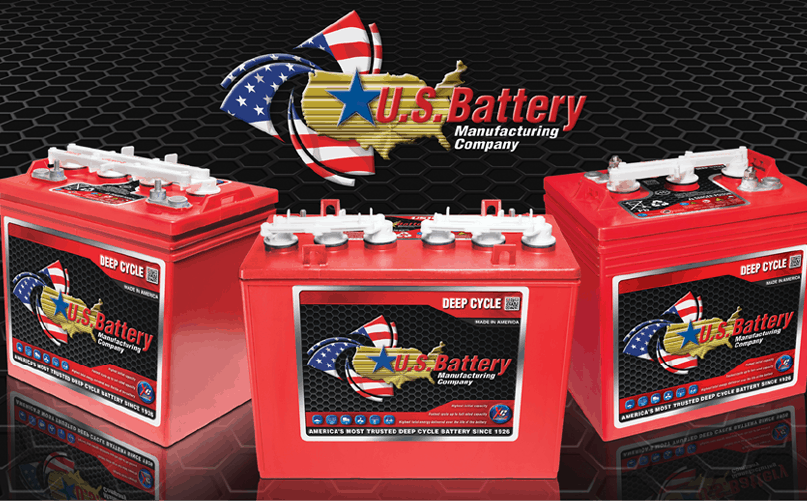
Deep-cycle flooded lead-acid batteries continue to be the most reliable and cost-effective sources of energy, which is why they are widely used in electric golf cars. While these types of batteries are very popular with individuals and owners of golf car fleets, improper maintenance is common, and can decrease performance and shorten battery life. Over the years, battery manufacturers have seen lots of battery maintenance blunders. Despite this, some of the most common mistakes can be avoided, resulting in longer battery life and potentially decreasing annual operating costs.
Overcharging: When a battery is overcharged, it accelerates the corrosion of the positive plates and increases the amount of water loss that occurs during charging. To prevent overcharging, make sure your battery charger is functioning correctly, is adequately sized for the battery set, and has a charge algorithm recommended by the battery manufacturer. The best way to identify overcharging is by taking specific gravity readings with a hydrometer and comparing the values with the manufacturer’s specifications.
Undercharging: Operating a battery that isn›t fully charged happens when vehicles need to be put back into service quickly. Unfortunately, this leads to progressive undercharge and hard sulfation that can hinder charging and negatively affect battery performance. The best way to avoid undercharging is to make sure that the batteries have enough time to complete a charge cycle. Verify your batteries are getting a full charge by checking the cells’ specific gravity with a hydrometer. If the batteries have the fully charged specific gravity reading indicated by the manufacturer, the vehicle is ready for service.
Battery Storage: Another prevalent mistake is storing a vehicle with its batteries in a discharged state. Leaving batteries discharged for an extended period of time can also cause sulfation. The main reason most golf cars go into storage is that cold conditions may prohibit their use. In addition to sulfation problems, when batteries are stored in a discharged state in cold climates, the batteries› electrolyte can freeze and damage the battery case. By fully charging batteries before they go into storage and boosting every 60 days, you›ll prevent sulfation and freezing related problems.
Under Watering: The most basic maintenance procedure for flooded lead-acid batteries is often the one that is most commonly ignored. When batteries are charged, gassing of the electrolyte causes the loss of water through electrolysis. While this gassing is completely normal and actually beneficial to the batteries, the water loss must be replaced to prevent damage to the battery plates. Most manufacturers recommend adding water every 30 days and never allowing the electrolyte to fall below the plates. Follow your manufacturer›s recommendations for watering procedures to ensure proper maintenance.
Over Watering: While watering is extremely important to the battery, it is also important to add the correct amount of water. By over watering, you can cause the electrolyte to overflow from the cells and spill out of the battery, diluting the electrolyte and diminish its performance. This can occur when watering batteries that are not fully charged. Over watering can also happen when fleet owners utilize single-point watering systems with unregulated flow or defective filling components. When watering, ensure you follow the battery and watering system manufacturer’s recommendations, as well as check fill-levels periodically to ensure proper watering system operation.
Deep Discharging: Trying to get every last bit of power out of your golf car›s batteries is never a good idea. Higher depth of discharge (DOD) levels can dramatically shorten battery life and result in having to purchase batteries more often. Battery manufacturers recommend never allowing batteries to go past a recommended 50% DOD and to charge the batteries at the first available opportunity. Deep-cycle batteries should always be allowed to fully charge before they are put into service again.
Knowing how to avoid some of these common mistakes can dramatically improve the performance of your deep-cycle batteries. While some may think these are small issues, making these maintenance mistakes can, in some instances, more than double your annual operating costs. So, to ensure costs are kept low and your golf car or fleet is ready for action, keep your batteries properly maintained.

Explore the October 2020 Issue
Check out more from this issue and find your next story to read.
Latest from Golf Course Industry
- From the publisher’s pen: Conscientious of a bigger role
- Bernhard and Company partners with Laguna Golf Phuket
- Terre Blanche showcases environmental stewardship
- VIDEO: Introducing our December issue
- Bernhard and Company introduces Soil Scout
- Nu-Pipe donates to GCSAA Foundation’s Centennial Campaign
- GCSAA enhances golf course BMP tool
- Melrose leadership programs sending 18 to 2026 GCSAA Conference and Trade Show





